Abstract
Peptic ulcers are a broad term that includes ulcers of digestive tract in the stomach or the duodenum. The formation of peptic ulcers depends on the presence of acid and peptic activity in gastric juice plus a breakdown in mucosal defenses. There are two major factors that can disrupt the mucosal resistance to injury: non-steroidal antiinflammatory drugs (NSAIDs) example, aspirin and Helicobacter pylori infection. Numerous natural products have been evaluated as therapeutics for the treatment of a variety of diseases, including peptic ulcer. There has been considerable pharmacological investigation into the antiulcer activity of some compounds. In this work, we shall review the literature on different medicinal plant and alkaloids with antiulcer activity. This article reviews the antiacid/anti-peptic, gastroprotective and/or antiulcer properties of the most commonly employed herbal medicines and their identified active constituents. The experimental parameters used for antiulcer activity were cold restraint stress-induced ulcer model, Diclofenac-induced ulcer model in rats, (HCl–ethanol)-induced ulcer in mice and water immersion stress-induced ulcer in rats. The ideal aims of treatment of peptic ulcer disease are to relieve pain, heal the ulcer and delay ulcer recurrence. About 70% of patients with peptic ulcer disease are infected by Helicobacter pylori and eradication of this microorganism seems to be curative for this disease. This article reviews drugs derived from medicinal plant more commonly used in the world for peptic ulcer and, if reported, the antiulcer activity. This article will be concerned only with the antiulcer and gastro-protective effects.
Keywords: Alkaloids, antiulcer activity, flavonoids, peptic ulcer, saponin, tannins
INTRODUCTION
An ulcer is basically an inflamed break in the skin or the mucus membrane lining the alimentary tract. Ulceration occurs when there is a disturbance of the normal equilibrium caused by either enhanced aggression or diminished mucosal resistance. About 19 out of 20 peptic ulcers are duodenal. Gastric ulcers, found in the stomach wall, are less common. The gastric mucosa is continuously exposed to potentially injurious agents such as acid, pepsin, bile acids, food ingredients, bacterial products (Helicobacter pylori) and drugs. These agents have been implicated in the pathogenesis of gastric ulcer, including enhanced gastric acid and pepsin secretion, inhibition of prostaglandin synthesis and cell proliferation growth, diminished gastric blood flow and gastric motility.[1]
Drug treatment of peptic ulcers is targeted at either counteracting aggressive factors or stimulating the mucosal defenses;
The goals of treating peptic ulcer disease are to relieve pain, heal the ulcer and prevent ulcer recurrence.
A large number of spices and herbs have been evaluated by various researchers for their antiulcer effects to achieve a favorable outcome. Large numbers of medicinal plants and dietary nutrients have been shown to possess gastro-protective activities such as Aloe, Terminalia Chebula, Vetiveria Ziziinoides, Ginseng, Capsicum etc.
The potential medicinal plants used in ulcer
In spite of being one of the well-known medicinal plants used inIndian traditional medicine to treat several ailments, studies pertaining to the pharmacologicalproperties of some medicinal plants are very scarce. We studied the antiulcer activity and acute toxicity of some medicinal plants. Our investigation showed that these investigated medicinal plants could prevent ulcer in rats in a dose-dependent manner. Histological studies revealed that these medicinal plants did not show any acute toxicity. Preliminary photochemical screening of this medicinal plant identified the presence of important secondary metabolites like flavonoids and tannins.
A variety of botanical products have been reported to possess antiulcer activity but the documented literature has centered primarily on pharmacological action in experimental animals. Except for a few phytogenic compounds (i.e. aloe, liquorice and chilly), limited clinical data are available to support the use of herbs as gastro-protective agents and thus, the data on efficacy and safety are limited. Despite this, there are several botanical products with potential therapeutic applications because of their high efficacy and low toxicity. Finally, it should be noted that substances such as flavonoids, aescin, aloe gel and many others, that possess antiulcer activity are of particular therapeutic importance as most of the antiinflammatory drugs used in modern medicine are ulcerogenic.[2–4]
Active principles of antiulcer activity are Flavonoids, terpenoids and tannins.
Some medicinal plants used in the treatment of ulcer:
Ficus arnottiana
Family: Moraceae
Part used: Fruits, leafs
Common name:paras papal.
Active constituent: Fruits of the plant contain β-sitosterol, Gluanol acetate and Glucose, Friedelin, Sterols, alkaloids, Carbohydrates, Tannins, Phenols.
Chemical structure [Table 1, Scheme 1]
Table 1.
Some potential plants with antiulcer activity[2]
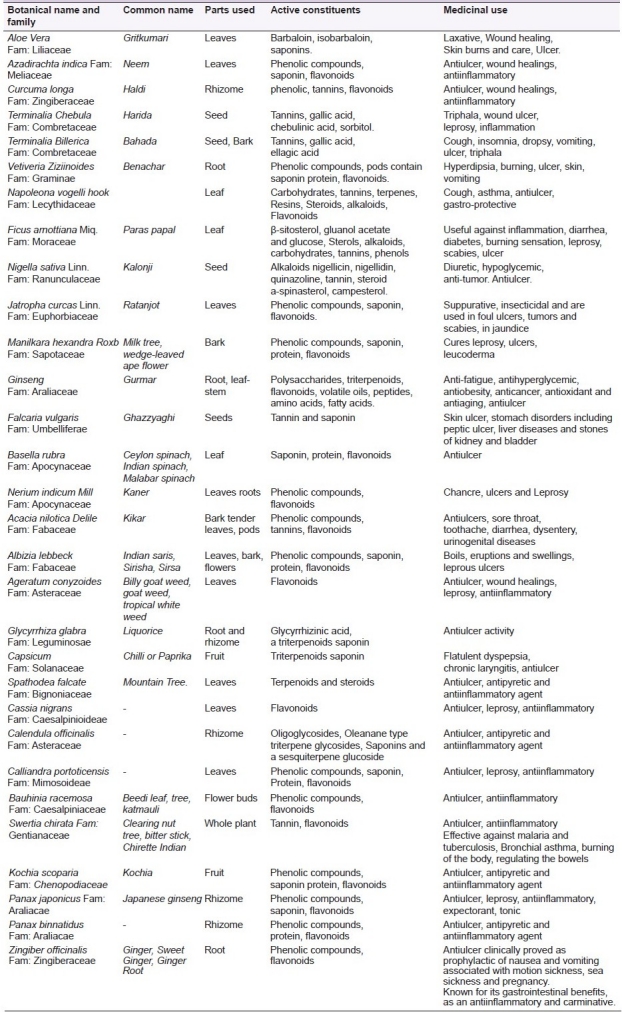
Scheme 1.

Description: It is an important traditional medicinal plant distributed throughout India, mostly in rocky hills of 1350 m elevations. It has several vernacular names including Para's pipal and kodiarasu. The fruits of the plant contain β-sitosterol, gluanol acetate and glucose, friedelin. Sterols, alkaloids, carbohydrates, tannins, phenols and so on are present in the bark extracts. Bark and leaf extract of this plant is being used in the traditional medicine. Bark of the plant is used as astringent, aphrodisiac, demulcent, depurative and emollient. It is also useful against inflammation, diarrhea, diabetes, burning sensation, leprosy, scabies, wounds and ulcer and skin diseases. Uses: Useful against inflammation, diarrhea, diabetes, burning sensation, leprosy, scabies, wounds, ulcer and skin diseases
Alstonia Scholaris R. Br.
Local name: Saptaparna
Family: Apocynaceae
Classification:
Kingdom: planate
Order: Gentianales
Genus: Alstonia
Description: Alstonia (devil tree) consists of about 40–60 species native to tropical and subtropical with most species in the Malaysian region. These trees can grow very large, such as Alstonia pneumatophore, recorded with a height of 60 m and a diameter of more than 2 m. Alstonia longifolia is the only species growing in Central America. The leathery, sessile, simple leaves are elliptical, ovate, linear or lanceolate and wedge-shaped at the base. The leaf blade is dorsoventral, medium-sized to large and disposed oppositely or in a whorl and with entire margin. The leaf venation is pinnate, with numerous veins ending in a marginal vein. Alstonia trees are used in traditional medicine. The bark of the Alstonia constricta and the Alstonia scholaris is a source of a remedy against malaria, toothache, rheumatism and snake bites. The latex is used in treating coughs, throat sores and fever. Many Alstonia species are commercial timbers, called pule or pulai in Indonesia and Malaysia.
Active constituent: Alkaloids, coumarins, flavonoids, phlobatannin, reducing sugars, simple phenolic, steroids, saponins and tannins. Of the various phytochemicals estimated, lipid and saponin were found in larger amounts than others, whereas the alkaloid is 0.86%. The above different chemical compounds detected in A. scholaris, could make the plant useful in treating different ailments and have the potential for providing useful drug for human use. This is because the pharmacological activity of any plant is usually traced to particular compound. The presence of tannins and other phenolic compounds, which have antiseptic properties, could explain the use of this plant for the treatment of various diseases. It has also been mentioned that the antioxidant activity of plants might be due to their phenolic compounds.[9] Flavonoids are a group of polyphenolic compounds with known properties that include free-radical scavenging, inhibition of hydrolytic enzymes and anti-inflammatory actionThe saponin and flavonoids are used in ulcer treatments.
Chemical structure [Scheme 2]
Scheme 2.
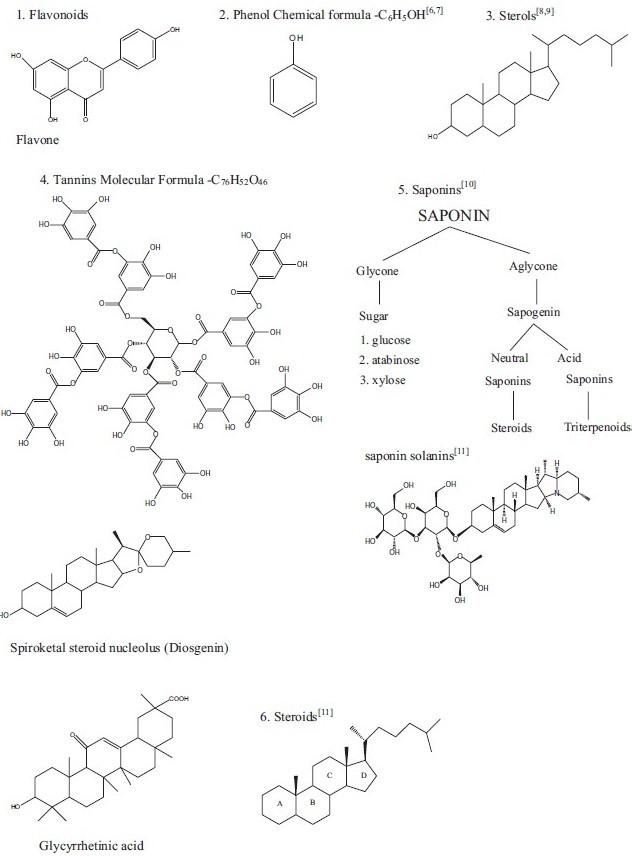
Use: Used in ulcers, dysentery and wood paste is applied in rheumatism and toothache.
Asparagus racemosus Willd
Local name: Satawari, satavari.
Family: Asparagaceae
Classification:
Kingdom: plantae
Phylum: Magnoliophyta
Class: liliopsida
Order: Asparagales
Family: Asparagaceae
Subfamily: Rhodendroideae
Tribe: rhododendreae
Genus: Asparagus
Specific epithet: Racemosus Willd.
Habitat: The plant grows best in tropical and subtropical dry and deciduous forests.
Part used: Shoots and tuberous roots.
Principal constituents: The principal chemical constituents exhibiting medicinal properties are Shatavarin (steroidal saponin). Four types of Shatavarin, Shatavarin I–IV are present in roots. Apart from this, quercitin-3-glucorinide, rutin in shoots; sitosterol, stigma sterol and some other unidentified saponins are found in fruits and seeds.[12]
Chemical structure [Scheme 3]
Scheme 3.
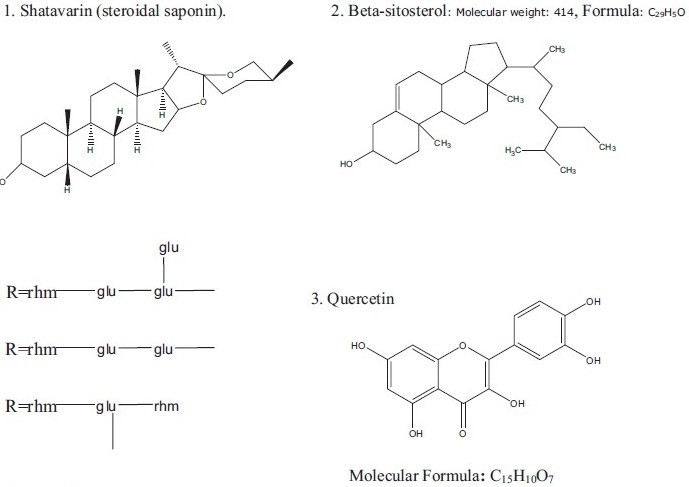
Description: The Sanskrit name Satamuli is in allusion to the numerous fusiform tubers of this plant. These are regarded as cooling, demulcent, diuretic, tonic and aphrodisiac, and are used both internally and in the preparation of several medicated oils. The tubers are candid and taken as a sweet-meat. This preparation however has scarcely any other taste or flavor besides that of the sugar. The fresh juice of the root is given with honey as a demulcent in bilious dyspepsia or diarrhea.
Use: Used in leucorrhoea, headache, useful in acidity. It is given to pregnant ladies before they deliver babies, it is said to relieve pains. Root powder is used to increase vigor and strength; roots are used as an antiinflammatory, antiulcerogenic, antitumor activity.[13]
Azadirachta indica Juss. Syn. Melia azadirachta L.
Botanical name: Azadirachta indica
Family: Meliaceae
Common names: Neem, nim, Indian lilac, nimmi, limbo, limda
Part used: leaves, flower, oil and seed.
Habitat: It is evergreen and grows throughout India.
Description: Neem is a native tree of India, a tropical tree especially suited to semi-arid conditions. It is now grown in many Asian countries and in the tropical regions of the western hemisphere. Neem is considered to be part of India's genetic bio-diversity. It is a medium to large tree having short, straight bole, furrowed, dark brown to gray bark and dense rounded crown of pinnate leaves. The most active, currently identified ingredient of Neem is ‘azadirachtin’. It finds applications in neem-based pesticide formulations that are safe, natural, bio-degradable and manageable at the farmer's level and environment friendly, unlike chemical and synthetic pesticides, which leave behind residues polluting air, water and soil.
Chemical constituents: There are many active compounds found in the neem tree. The most common ones are:[14–16] Azadirachtin : Provides repellent, anti-hormonal and anti-feedant properties
Nimbin: Provides anti-inflammatory, antipyretic, antihistamine and antifungal properties
Nimbidin: Provides antibacterial, antiulcer, analgesic, antiarrhythmic and antifungal properties
Nimbidol: Provides antitubercular, antiprotozoan and antipyretic properties
Sodium nimbinate: Provides diuretic, spermicidal and antiarthritic properties
Quercetin: Provides antiprotozoal, antioxidant, antiinflammatory and antibacterial properties
Neem seed oil contains the major concentrations of these active compounds along with many fatty acids like oleic acid, stearic acid, palmitic acid, linoleic acid and so on. Lesser amounts of these active compounds are also found in Neem leaves and bark.
Chemical structure [Scheme 4]
Scheme 4.
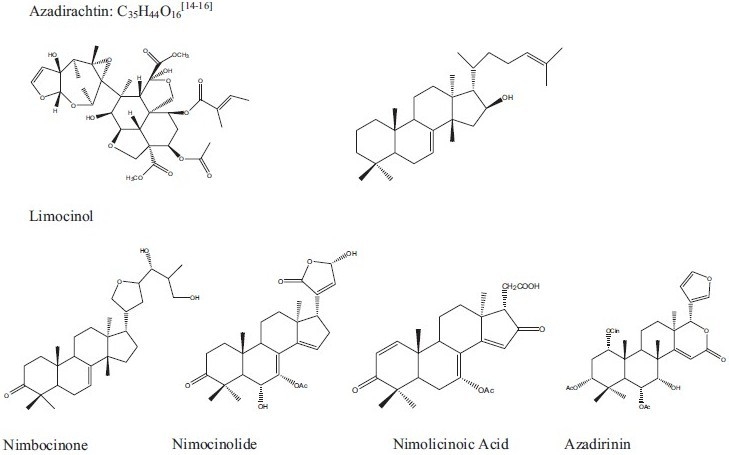
Azadirinin
Use: Seeds are used in skin diseases, and in rheumatism. Bark is useful in malarial fever. Dry fruits are used as tonic and stomachic. Tender twigs are used as tooth brush.
Bauhinia variegata Linn.
Local name: Kachnar, Kaniar
Family: Fabaceae
Habitat: It grows throughout India, ascending to an altitude of 1300 m in the Himalayas.
Description: Bauhinia variegata is a medium-sized, deciduous tree. The bark is gray, the leaves are sub-coriaceous and deeply cordate; the flowers are variously colored and occur in few flowered, lateral corymbs; the pods are long, hard, flat, glabrous and dehiscent and 10–15 seeded.
Principal constituents: The seeds yield fatty oil, the bark yields fiber. Five flavonoids isolated from the different organs of B. variegata were identified as Quercetin, rutin, Quercetin, apigenin and apigenin 7-O-glucoside. Saponins, steroids, flavonoids, alkaloids, tannins, sugars are also present.[17]
Macroscopically characteristics
The shape of B. variegata leaves is linear-lanceolate with entire margin, broad and rounded and bilobed apex, smooth and glabrous surface, running parallel venation, length varying from 10 to 13 cm and breath is broader than long, cleft 1/4 to 1/3 of the way down into two obtuse lobes, green when fresh and brown when it is dry, weak odor and slightly bitter in taste.[17,18]
Chemical structure [Scheme 5]
Scheme 5.
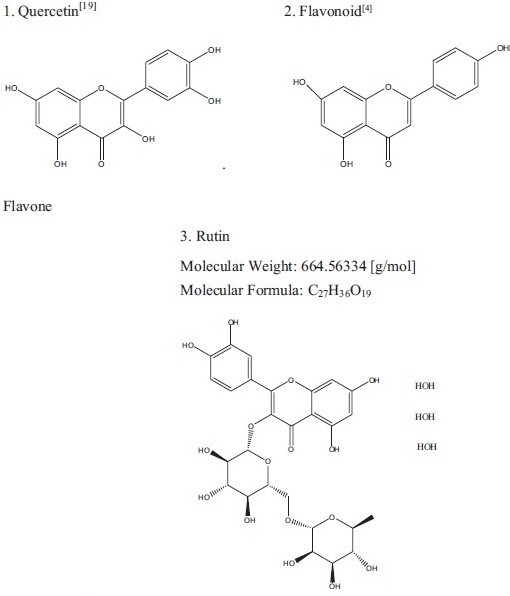
1. Quercetin[19]
2. Flavonoid[4]
Uses: The bark is astringent, tonic and anthelmintic. It is useful in scrofula and skin diseases. It is also used for ulcers and leprosy. A decoction of the bark is taken for dysentery. The dried buds are used for diarrhea, dysentery and hemorrhoids. It is also used for ulcers and leprosy. The stem bark is employed in drug formulations considered useful in ulcers, scrofula and asthma and skin diseases. It is used to remove intestinal worms and to prevent the decomposition of the blood in tumors. The root is carminative, and is used in dyspepsia and flatulence. A decoction of the root is reported to prevent obesity. The flowers and flower buds are used as a vegetable.[17,18]
Butea frondosa Roxb.
Local name: Palaas
Family: Fabaceae
Classification:
Kingdom: Plantae
Division: Magnoliophyta
Class: Magnoliopsida
Order: Fabales
Family: Fabaceae
Subfamily: Faboideae
Genus: Butea
Species: B. Monosperm
Description: It is a species of Butea, native to tropical southern Asia, from Pakistan, India, Bangladesh, Nepal, Sri Lanka, Myanmar, Thailand and western Indonesia. It is a medium-sized growing to 15 m tall. The leaves are pinnate, with an 8–16 cm petiole and three leaflets, each leaflet 10–20 cm long. The flowers are 2.5 cm long, bright orange-red and produced in racemes up to 15 cm long. The fruit is a pod 15–20 cm long and 4–5 cm broad. It is used for timber, resin, fodder, medicine and dye. The gum from the tree is used in certain food dishes. The wood is dirty white and soft and, being durable under water, is used for well-curbs and water scoops. Good charcoal can be made from it.
Principal constituents: The main constituent of the flower is butrin (1.5%) besides butein (0.37%) and butin (0.04%). It also contains flavonoids and steroids. Later studies proves that isobutrin slowly change to butrin on drying. Other than these in flowers, coreopsis, isocoreopsin, sulfuring (glycoside) and other two with monospermoside and isomonospermoside structures are also identified. Roots contain glucose, glycine, glucoside and aromatic compounds. Tetramers of leucocyanidin are isolated from gum and stem bark. Seed contains oil. The bright color of the flower is attributed to the presence of chakones and aurones.
Chemical Structure [Scheme 6]
Scheme 6.
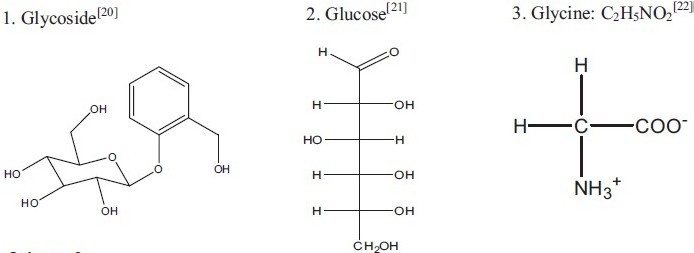
Medicinal uses: The fresh juice is applied to ulcers and for congested and septic sore throats. The gum is a powerful astringent given internally for diarrhea and dysentery, phthisis and hemorrhage from stomach and the bladder, in leucorrhea, ringworm and as a substitute for gum Kino. The bark is reported to possess astringent bitter, pungent, alliterative, aphrodisiac and anthelmintic properties. Useful in tumors, bleeding piles and ulcers. The decoction is useful in cold, cough, fever and menstrual disorders. Roots are useful in elephantiasis and in curing night blindness and other eyesight defects. Also cause temporary sterility in women. Also applied in sprue, piles, ulcers, tumors and dropsy. Leaves have astringent, tonic, diuretic and aphrodisiac properties. They are also used to cure boils, pimples and tumors hemorrhoids and piles. Also used as beedi wrappers. Flowers are reported to possess astringent, diuretic, depurative, aphrodisiac and tonic properties. They are used as emmenagogue and to reduce swellings. Also effective in leprosy, leucorrhoea and gout.
Carica papaya L.
Local name: Papitta
Family: Caricaceae
Classification:
Kingdom: Plantae
Subkingdom: Tracheobionta
Superdivision: Spermatophyta
Division: Magnoliophyta
Class: Magnoliopsida
Subclass: Dilleniidae
Order: Violales
Family: Caricaceae
Genus: Carica L.
Species: Carica papaya L.
Description: Papaya is a fast-growing, semi-woody tropical herb. The stem is single, straight and hollow and contains prominent leaf scars. Papaya exhibits strong apical dominance rarely branching unless the apical meristem is removed, or damaged. The fruit is melon-like, oval to nearly round, somewhat pyriform, or elongated club-shaped, 15–50 cm long and 10–20 cm thick and weighing up to 9 kg. Semi-wild (naturalized) plants bear small fruits 2.5–15 cm in length. The skin is waxy and thin but fairly tough. When the fruit is immature, it is rich in white latex and the skin is green and hard. As ripening progresses, papaya fruits develop a light- or deep-yellow-orange colored skin while the thick wall of succulent flesh becomes aromatic, yellow orange or various shades of salmon or red. It is then juicy, sweetish and somewhat like a cantaloupe in flavor but some types is quite musky. Mature fruits contain numerous grey-black ovoid seeds attached lightly to the tannin.[23]
Medicinal properties: Papaya is used in tropical folk medicine. Papaya latex is very much useful for curing dyspepsia and is externally applied to burns and scalds. The fruit and seeds have anthelmintic and antiamebic activities. It contains many biologically active compounds. Two important compounds are chymopapain and papain, which are widely known as being useful for digestive disorders and disturbances of the gastrointestinal tract.
Chemical constituents and components: Main chemical components are papain, chymopapain, pectin, carposide, carpaine, pseudocarpaine, dehydrocarpines, carotenoids, crypto glavine, cis-violaxanthin and antheraxanthin.[23,24]
Action: Papain:
It regulates the expression of replicase polyproteins.
It is a strong digestive enzyme and useful in serious digestive disorders such as bloating and chronic indigestion.
Unique ability of Papain is to break down protein and convert a portion of it into arginine because arginine influences the production of the human growth hormone.
Chemical Structure [Scheme 7]
Scheme 7.
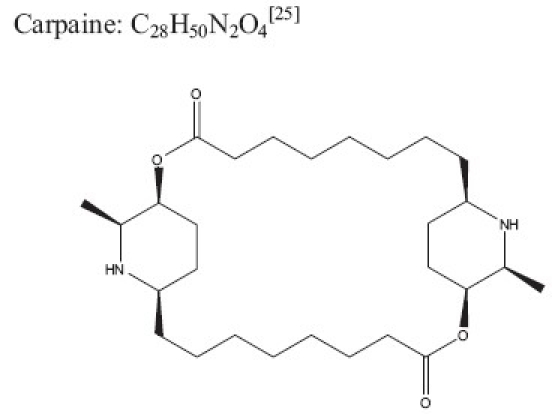
Uses: Papaya is basically an agent that helps in the digestive process. The leaves of the tree as well as the fruit, both ripe and raw, are used medicinally to aid digestion. It is interesting to note the unripe papaya fruit is medicinally more advantageous. The milky white sap produced by the trunk of the papaya tree is also a useful remedy and is applied externally to accelerate the curing of abrasions, ulcers, boils, warts and cancerous growth. The papaya seeds are also useful as when ingested they help in throwing out worms from the body. The latex or the white sap produced by the papaya tree trunk is also effectual in this manner, but comparatively more aggressive. On the other hand, an infusion prepared with the flowers of the plant may be used to stimulate menstruation. The decoction prepared by boiling the ripe fruit in water is useful for curing enduring diarrhea and dysentery among children. While the raw papaya contains a white milky substance called papain, the ripe fruit is moderately laxative and helps in the movement of bowels. The leaves of the papaya tree are useful too as they are often used for dressing wounds and injuries[23,24].
Annona squamoza
Common name: Seetha, Anonang-baker, Anono, Guma
Family: Annonaceae
Classification:
Kingdom: Plantae
Subkingdom: Tracheobionta
Superdivision: Spermatophyta
Division: Magnoliophyta
Class: Magnoliopsida
Subclass: Magnoliidae
Order: Magnoliales
Family: Annonaceae
Genus: Annona L.
Species: Annona squamosa L.
Description: A tree growing to a height of 5 to 10 m, deciduous and smooth or nearly so. Leaves are alternate, ovate to oblong-ovate or elliptic-ovate, 6 to 10 cm long, with entire or undulate margins, pointed tip and with pointed, rounded or heart-shaped base. Flowers are stalkless, white or yellowish-white, about 7 mm long and borne in lax inflorescences 5 to 10 cm long. The calyx is ovoid. The corolla tube is no longer than the calyx with spreading and reflexed lobes. Throat of the corolla and stamens are hairy. Fruit is a drupe, yellowish white or pinkish, ovoid, 10 to 13 mm long with a rather scanty pulp and a hard stone. The persistent calyx in the fruit is broadly funnel-shaped, enlarged and about 8 mm diameter.
Distribution: Throughout the Philippines. Common in secondary forests and thickets and low and medium altitudes.
Chemical constituents
Bark contains a large amount of tannic acid. Fruit pulp contains sugar, gum, extractive matters and ash. Bark contains a principle similar to ‘cathartin’. Fruit is considered demulcent; the bark, astringent and tonic.
Chemical structure [Scheme 8]
Scheme 8.
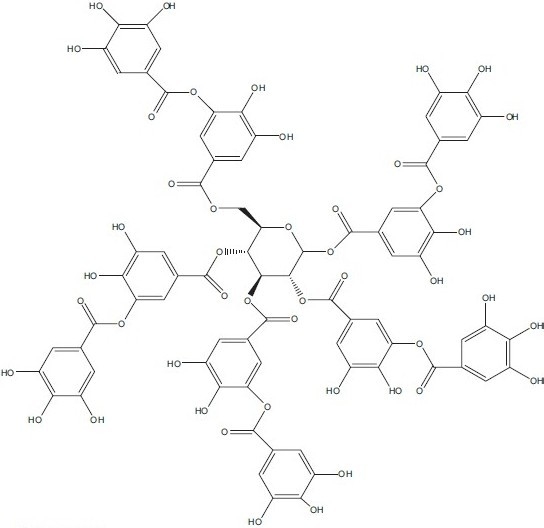
Tannic acid
MW: 772.57, Formula: C34H28O21
Part used: Leaves, fruit, seeds, bark.
Uses: The bark is moistened and applied to boils and tumors to hasten ripening. Also used for headaches and stomach aches. Bark is used as antidyspeptic and as febrifuge. Powdered bark is used for mouth ulcers. Infusion of bark is used as gargle. The bark juice, mixed with coconut milk, is used to relieve colicky pains. The barks are rubbed on the teeth to strengthen them. Leaves are used for ulcers and headaches. The highly mucilaginous fruit is used for coughs and ailments of the chest, uterus and urethra. In large quantities, used as a laxative .stem-bark extract is used as a Antidiarrhoeal activity.[2,26,27]
CONCLUSION
From this study, it is clear that the medicinal plants play a vital role against various diseases. Various herbal plants and plants extracts have significant antiulcer activity in animal models. It has muco-protective activity and gastric anti-secretary when compared with that of reference drugs. The extract is non-toxic even at relatively high concentrations. The antiulcer activity is probably due to the presence of flavonoids in all this plants. Our results showed that above-mentioned medicinal plants could prevent ulcer in rats in a dose-dependent manner. A variety of botanical products have been reported to possess antiulcer activity; finally, it should be noted that substances such as flavonoids, and tannins that possess antiulcer activity are of particular therapeutic importance. The results of this study indicate that extracts of leaves and plants extracts of some medicinal plant have good potentials for use in peptic ulcer disease. Our results showed that these medicinal plants could prevent ulcer in rats in a dose-dependent manner. The present study was designed to explore the mechanism of action of medicinal plants against experimentally induced gastric ulcers. The bark extracts were tested against aspirin- and ethanol-induced gastric ulcer models and histamine infusion-induced gastric acid secretion model in rats. It is concluded from this study that the drug possesses antiulcer activity in different gastric ulcer models. The antiulcer activity of the drug can be attributed to free-radical scavenging property, inhibition of acid secretory parameters and strengthening of gastric mucosal barrier.
Footnotes
Source of Support: Nil
Conflict of Interest: None declared
REFERENCES
- 1.Grossman M. Am J Pharm Toxicol. Vol. 4. Chicago: Year Book Medical Publishers; 2009. Peptic ulcer: A guide for the practicing physician; p. 79. (89-93). [Google Scholar]
- 2.Kokate CK, Purohit AP, Gokhale SB. Pharmacognosy. 13th ed. Pune: Nirali Prakashan Publisher; 2007. p. 35. [Google Scholar]
- 3.Warrier PK, Nambiar VP, Raman Kutty C. Indian medicinal plants: A compendium of 500 species. Hyderabad: Orient Longman Publisher; 1994. p. 23. [Google Scholar]
- 4.Parmar NS, Parmar S. Anti-ulcer potential of flavonoids. Indian J Physiol Pharmacol. 1998;42:343–51. [PubMed] [Google Scholar]
- 5.Roubroeks JP, Andersson R, Mastromauro DI, Christensen BE, Aman P. Molecular weight, structure and shape of oat (1-3),(1-4)-b-D-glucan fractions obtained by enzymatic degradation with (1-4)-b-D-glucan 4-glucanohydrolase from Trichoderma reesei, carbohydrates. Polymer. 2001;46:275–85. [Google Scholar]
- 6.Pearson A, Budin M, Brocks JJ. Phylogenetic and biochemical evidence for sterol synthesis in the bacterium Gemmata obscuriglobus. Proc Natl Acad Sci U S A. 2003;100:15352–7. doi: 10.1073/pnas.2536559100. [DOI] [PMC free article] [PubMed] [Google Scholar]
- 7.Trease GE, Evans WC. A textbook of Pharmacognosy. 14th ed. London: Bailliere Tindall Ltd; 1996. [Google Scholar]
- 8.Cook NC, Samman S. Flavonoids-chemistry, metabolism, cardio protective effects and dietary sources. Nutr Biochem. 1996;7:66–76. [Google Scholar]
- 9.Frankel E. International conference on food factors: Chemistry and cancer prevention. Hamamatsu: Japan Abstracts; 1995. Nutritional benefits of flavonoids; pp. C6–2. [Google Scholar]
- 10.Baker JT. Saponin. [last retrieved on 2009 Feb 23]. Available from: http://www.jtbaker.com/msds/englishhtml/S0746.htm .
- 11.IUPAC-IUB Joint Commission on Biochemical Nomenclature (JCBN). The nomenclature of steroids. Recommendations 1989. Eur J Biochem. 1989;186:429–58. [PubMed] [Google Scholar]
- 12.Goel RK, Sairam K. Anti-ulcer drugs from indigenous sources with emphasis on Musa sapientum, Asparagus racemosus and Zingiber officinale. Indian J Pharmacol. 2002;34:100–10. [Google Scholar]
- 13.Mazumder PM, Farswan M, Parcha V, Singh V. Hypoglycaemic and antioxidant activity of an isolated compound from Ficus arnottiana bark. Pharmacologyonline. 2008 [Google Scholar]
- 14.Veitch GE, Beckmann E, Burke BJ, Boyer A, Maslen SL, Ley SV. Synthesis of azadirachtin: A long but successful journey. Angew Chem Int Ed Engl. 2007;46:7629–32. doi: 10.1002/anie.200703027. [DOI] [PubMed] [Google Scholar]
- 15.Senthil NS, Kalaivani K, Murugan K, Chung G. The toxicity and physiological effect of Neem limonoids on Cnaphalocrocis medinalis (Guenée) the rice leaf folder pesticide. Biochem Physiol. 2005;81:113. [Google Scholar]
- 16.Nathan SS, Kalaivani K, Murugan K. Effects of neem limonoids on the malaria vector Anopheles stephensi Liston (Diptera: Culicidae) Acta Trop. 2005;96:47–55. doi: 10.1016/j.actatropica.2005.07.002. [DOI] [PubMed] [Google Scholar]
- 17.Anonymous. The wealth of India. A Dictionary of Indian Raw Materials and Industrial Products. 1998;2(B):49–52. [Google Scholar]
- 18.Pharmacopoeia of India. Vol. 2. New Delhi: Controller of Publication, Ministry of Health and Family Welfare, Govt. of India; 1996. Anonymous; pp. A53–4. [Google Scholar]
- 19.The Merck index: An encyclopedia of chemicals, drugs, and biological. 11th ed. Merck: United States pharmaceutical company Merck & Co; 1989. p. 4386. ISBN 091191028X. [Google Scholar]
- 20.Brito-Arias M. Synthesis and characterization of glycosides. New York: Springer; 2007. p. ISBN 978-0-387-26251-2. [Google Scholar]
- 21.Lindhorst TK. Essentials of carbohydrate chemistry and biochemistry. Wiley: VCH; 2007. p. ISBN 978-3527315284. [Google Scholar]
- 22.Moss GP. Nomenclature and symbolism for amino acids and peptides (IUPAC-IUB Recommendations. Pure Appl Chem. 1984;56:595–624. [Google Scholar]
- 23.Drenth J, Jansonius JN, Koekoek R, Wolthers BG. The structure of papain. Adv Protein Chem. 1971;25:79–115. doi: 10.1016/s0065-3233(08)60279-x. [DOI] [PubMed] [Google Scholar]
- 24.Burdick, Carpaine EM. An alkaloid of Carica papaya. Chemistry and pharmacology. Econ Bot. 1971;25:363–5. [Google Scholar]
- 25.Hornick CA, Sanders LI, Lin YC. Effect of carpaine, a papaya alkaloid, on the circulatory function in the rat. Res Commun Chem Pathol Pharmacol. 1978;22:277–89. [PubMed] [Google Scholar]
- 26.Santos AF, Santana AE. Mollusicaidal properties of some of some species of annona. Phytomedicine. 2001;8:115–20. doi: 10.1078/0944-7113-00008. [DOI] [PubMed] [Google Scholar]
- 27.Suleiman MM, Dzenda T, Sani CA. Published a Research Article on Antidiarrhoeal activity of the methanol stem-bark extract of Annona squamoz (Annonaceae) 1999 doi: 10.1016/j.jep.2007.11.007. [DOI] [PubMed] [Google Scholar]


